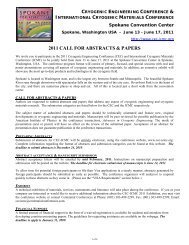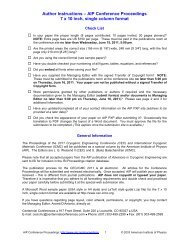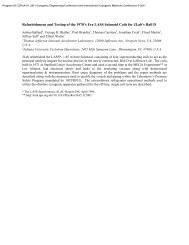CEC Abstracts in PDF format (as of 7/3/07) - CEC-ICMC 2013
CEC Abstracts in PDF format (as of 7/3/07) - CEC-ICMC 2013
CEC Abstracts in PDF format (as of 7/3/07) - CEC-ICMC 2013
You also want an ePaper? Increase the reach of your titles
YUMPU automatically turns print PDFs into web optimized ePapers that Google loves.
<strong>CEC</strong> 20<strong>07</strong> - <strong>Abstracts</strong><br />
C1-Q-06 Piezo-Hydraulic Actuation for Driv<strong>in</strong>g High<br />
Frequency M<strong>in</strong>iature Split-Stirl<strong>in</strong>g Pulse Tube<br />
Cryocoolers<br />
I. Garaway, G. Grossman, Technion - Israel Institute<br />
<strong>of</strong> Technology.<br />
In recent years piezoelectric actuation h<strong>as</strong> been identified <strong>as</strong> a<br />
promis<strong>in</strong>g means <strong>of</strong> driv<strong>in</strong>g m<strong>in</strong>iature Stirl<strong>in</strong>g devices. It supports<br />
m<strong>in</strong>iaturization, h<strong>as</strong> a high power to volume ratio, can operate at<br />
almost any frequency, good electrical to mechanical efficiencies, and<br />
potentially h<strong>as</strong> a very long operat<strong>in</strong>g life. The major drawback <strong>of</strong><br />
piezoelectric actuation, however, is the very small displacements that<br />
this physical phenomenon produces. This study shows that by<br />
employ<strong>in</strong>g valve-less hydraulic amplification, an oscillat<strong>in</strong>g pressure<br />
wave can be created that is sufficiently large to drive a high frequency<br />
m<strong>in</strong>iature pulse tube cryocooler (<strong>as</strong> high <strong>as</strong> 350 Hz <strong>in</strong> our<br />
experiments, and perhaps higher). Beyond the direct benefits<br />
derived from us<strong>in</strong>g piezoelectric actuation there are further benefits<br />
derived from us<strong>in</strong>g the piezo-hydraulic arrangement with membranes.<br />
Due to the <strong>in</strong>compressibility <strong>of</strong> the hydraulic fluid the actuator may be<br />
separated from the ma<strong>in</strong> body <strong>of</strong> the cryocooler by relatively large<br />
distances with almost no detrimental effects, and the complete lack <strong>of</strong><br />
rubb<strong>in</strong>g parts <strong>in</strong> the power conversion processes makes this type <strong>of</strong><br />
cryocooler extremely robust. The design and experimental device<br />
along with some test results will be presented.<br />
C1-Q-<strong>07</strong> Demonstration <strong>of</strong> a superconduct<strong>in</strong>g detector<br />
cooled by electron-tunnel<strong>in</strong>g refrigerators<br />
J.N. Ullom, J.A. Beall, W.D. Duncan, F. F<strong>in</strong>kbe<strong>in</strong>er,<br />
G.C. Hilton, K.D. Irw<strong>in</strong>, D.R. Schmidt, L.R. Vale,<br />
NIST; N.A. Miller, G.C. O`Neil, NIST/University <strong>of</strong><br />
Colorado Boulder; D.J. Benford, J.A. Chervenak,<br />
S.H. Moseley, R.F. Silverberg, NASA GSFC; T.C.<br />
Chen, Global Science and Technology.<br />
We have successfully cooled a Transition-Edge Sensor (TES) us<strong>in</strong>g<br />
th<strong>in</strong>-film, solid-state refrigerators b<strong>as</strong>ed on Normal metal/<br />
Insulator/Superconductor (NIS) tunnel junctions. The cool<strong>in</strong>g<br />
mechanism is the preferential tunnel<strong>in</strong>g <strong>of</strong> the highest energy (hottest)<br />
electrons through the bi<strong>as</strong>ed NIS junctions. We describe the cool<strong>in</strong>g<br />
performance, temperature noise, and energy resolution <strong>of</strong> the NIScooled<br />
TES. In particular, we show that the NIS refrigerators<br />
<strong>in</strong>troduce no detectable noise <strong>in</strong> the TES operation. We also describe<br />
ongo<strong>in</strong>g efforts to improve the cool<strong>in</strong>g performance <strong>of</strong> NIS<br />
refrigerators and the e<strong>as</strong>e with which they can be coupled to usersupplied<br />
payloads. NIS refrigerators can cool from temperatures near<br />
0.3 K to below 0.1 K. The calculated power dissipation to cool 1,000<br />
th<strong>in</strong>-film sensors is 1-10 microWatts. Comb<strong>in</strong><strong>in</strong>g a pumped He-3<br />
system with NIS refrigerators provides a compact, lightweight<br />
alternative to adiabatic demagnetization refrigerators and dilution<br />
refrigerators.<br />
Wednesday, <strong>07</strong>/18/<strong>07</strong> Plenary<br />
8:00am - 9:00am<br />
C2-A Wednesday Plenary Session<br />
Wednesday, <strong>07</strong>/18/<strong>07</strong> Oral<br />
9:00am - 10:30am<br />
C2-B He II Heat Transfer and Fluid<br />
Mechanics - II<br />
C2-B-01 An experimental study <strong>of</strong> He II two-ph<strong>as</strong>e flow<br />
<strong>in</strong> a long horizontal pipe<br />
M. Takah<strong>as</strong>hi, T. Kuriyama, T. Yazawa, I. Watanabe,<br />
K. Nakayama, Toshiba Corp.; Y. Ota, T. Okamura,<br />
Tokyo Tech.<br />
Superconductor cavities used <strong>in</strong> l<strong>in</strong>ear collider are cooled below 2K <strong>in</strong><br />
superfluid helium to enhance the generated electric field. In some<br />
l<strong>in</strong>ear collider such <strong>as</strong> planned <strong>in</strong> the International L<strong>in</strong>ear Collider<br />
project (ILC), the cryogenic system will have a considerably long<br />
horizontal pipe, more than hundred meters, <strong>in</strong> which two-ph<strong>as</strong>e<br />
superfluid helium flows. One <strong>of</strong> the key issue for the cryogenic design<br />
is the gradient <strong>of</strong> the liquid level <strong>in</strong> the pipe. It should be designed <strong>as</strong><br />
small <strong>as</strong> possible to cause the dry-out at somewhere <strong>of</strong> the pipe. We<br />
have developed a test apparatus <strong>of</strong> He II two-ph<strong>as</strong>e flow <strong>in</strong> a long<br />
pipe. The apparatus is comprised ma<strong>in</strong>ly <strong>of</strong> a He II vessel, a twoph<strong>as</strong>e<br />
flow pipe with 4 m <strong>in</strong> length and 32 mm <strong>in</strong> diameter, and some<br />
cavity vessels. Instead <strong>of</strong> cavities, electric heaters gave the thermal<br />
load. The gradient <strong>of</strong> the liquid level <strong>as</strong> a function <strong>of</strong> the load w<strong>as</strong><br />
me<strong>as</strong>ured by us<strong>in</strong>g two level meters. The experimental results were<br />
compared to numerical results.<br />
C2-B-02 Experimental facility for comparison <strong>of</strong> high<br />
Reynolds number turbulence <strong>in</strong> both HeI and HeII : first<br />
results<br />
B. Rousset, M. Bon Mardion, D. Communal, F.<br />
Daviaud, P. Diribarne, B. Durbrulle, A. Forge<strong>as</strong>, A.<br />
Girard, P. Roussel, CEA; C. Baudet, Y. Gagne, P;<br />
Thibault, UJF; B. C<strong>as</strong>ta<strong>in</strong>g, ENS; B. Hebral, P.<br />
Roche, CNRS.<br />
Turbulence SuperFluid (TSF) project will use cryogenic liquid helium<br />
for the fundamental study <strong>of</strong> turbulent phenomena. For this purpose<br />
we have carried out an experiment <strong>of</strong> p<strong>as</strong>sive grid turbulence which is<br />
able to work <strong>in</strong> HeI <strong>as</strong> well <strong>as</strong> <strong>in</strong> HeII. The flow <strong>of</strong> liquid helium will<br />
be generated by a cold Barber and Nichols circulat<strong>in</strong>g pump, where<strong>as</strong><br />
helium flow temperature is kept constant by means <strong>of</strong> a heat<br />
exchanger immersed <strong>in</strong> a saturated bath, which ma<strong>in</strong>ly evacuates the<br />
heat due to friction.<br />
This experiment will use the CEA Grenoble refrigerator (nom<strong>in</strong>al<br />
capacity <strong>of</strong> 400 Watt at 1.8 K) to remove the heat due to pressures<br />
losses <strong>in</strong> this high Reynolds number experiment. In order to solve the<br />
Kolmogorov scale <strong>as</strong>sociated with such high flow local<br />
<strong>in</strong>strumentation (e.g. sub-micrometer anemometer) w<strong>as</strong> developed.<br />
Use <strong>of</strong> this local and fragile <strong>in</strong>strumentation <strong>in</strong> a qu<strong>as</strong>i <strong>in</strong>dustrial<br />
environment arises some difficulties we discussed here while the<br />
solutions adopted are also described.<br />
F<strong>in</strong>ally, first results obta<strong>in</strong>ed both <strong>in</strong> superfluid and <strong>in</strong> normal helium<br />
are presented. For this l<strong>as</strong>t c<strong>as</strong>e, a permanent m<strong>as</strong>s flow rate <strong>of</strong> few<br />
hundreds <strong>of</strong> g/s w<strong>as</strong> achieved.<br />
C2-A-01 The COBE Mission: How Cryogenics is<br />
Revolutioniz<strong>in</strong>g Astronomy and Astrophysics<br />
J. Mather, NASA/Goddard Space Flight Center.<br />
The development <strong>of</strong> deep cool<strong>in</strong>g for space science applications h<strong>as</strong><br />
enabled an extraord<strong>in</strong>ary series <strong>of</strong> discoveries <strong>in</strong> <strong>as</strong>trophysics, rang<strong>in</strong>g<br />
from <strong>in</strong>frared <strong>as</strong>tronomy to X-ray <strong>as</strong>tronomy and tests <strong>of</strong> general<br />
relativity to observations <strong>of</strong> the Big Bang itself. I will describe the<br />
<strong>in</strong>strument package and the cool<strong>in</strong>g concepts used on the Cosmic<br />
Background Explorer satellite, and the scientific results that led to the<br />
Nobel Prize <strong>in</strong> Physics for 2006. The James Webb Space Telescope,<br />
now <strong>in</strong> preparation for launch <strong>in</strong> <strong>2013</strong>, will use both radiative and<br />
active cool<strong>in</strong>g to extend the science <strong>of</strong> the Hubble Space Telescope<br />
and the Spitzer Space Telescope. I will discuss the cool<strong>in</strong>g concepts<br />
for these missions and others, and speculate on the future <strong>of</strong><br />
cryogenics <strong>in</strong> space science.<br />
Page 20 <strong>of</strong> 53






